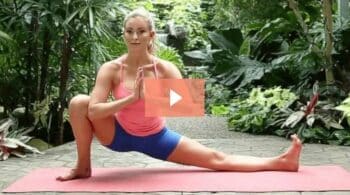Stress has become an inevitable part of our lives, often taking a toll on our mental and physical well-being. Managing stress is essential to maintain a healthy lifestyle. One effective method to address stress is through yoga poses. Yoga not only improves flexibility and strength but also relaxes the mind and relieves tension. In this article, we will explore the significance of stress management, discuss how yoga can aid in stress relief, and highlight some beneficial yoga poses.
What is stress management?
Stress management refers to techniques and practices designed to help individuals cope with and reduce stress levels. It involves identifying stress triggers, implementing strategies to counteract them, and achieving a state of calmness and balance. By actively practicing stress management, you can enhance your ability to respond to stressors in a healthier and more positive way.
The importance of stress management
Unmanaged stress can lead to various health issues such as anxiety, depression, insomnia, and even physical pain. Effective stress management not only promotes a better quality of life but also enhances overall well-being. It allows you to maintain a sense of control, effectively handle challenges, and improve your resilience to stressful situations.
How yoga can help with stress management
Yoga combines physical postures, breathing exercises, and meditation techniques to help calm the mind, release tension, and reduce stress levels. The practice of yoga encourages mindfulness, focusing your attention on the present moment, and letting go of worries and distractions. By engaging in yoga regularly, you can improve your emotional well-being, reduce anxiety, and promote a sense of inner peace.
Now, let’s explore some yoga poses specifically designed to relieve tension and manage stress effectively.
Relieving Tension: Yoga Poses for Stress Management
Yoga has long been recognized as an effective tool for stress management, providing a holistic approach to relieve tension and promote relaxation. By practicing specific yoga poses, you can alleviate the physical and mental strain caused by stress, allowing yourself to find balance and tranquility in your daily life.
Understanding Stress
Stress is a natural response to the demands and pressures of life. It can be triggered by various factors such as work-related challenges, personal relationships, or financial difficulties. This emotional and psychological strain can have significant effects on both the body and mind, leading to physical symptoms like muscle tension, headaches, and sleep disruption, as well as mental and emotional consequences such as anxiety, irritability, and difficulty concentrating.
Common Causes of Stress
The causes of stress vary from person to person, but some common triggers include excessive workload, time constraints, major life changes, and unresolved conflicts. Additionally, external factors like noise, pollution, and social media overload can also contribute to feelings of overwhelm and stress.
Effects of Stress on the Body and Mind
When under stress, your body enters a state of heightened alertness, releasing stress hormones that can negatively impact your health. Chronic stress can lead to an increased risk of heart disease, anxiety disorders, depression, and weakened immune function, among other health complications. Additionally, stress can impair cognitive function, making it difficult to concentrate, make decisions, and solve problems effectively.
By understanding the definition, common causes, and effects of stress, you can become more aware of its presence in your life. In the following sections, we will explore specific yoga poses and postures that can help you alleviate stress, relieve tension, and restore balance to your body and mind.
Benefits of Yoga for Stress Management
Yoga has been practiced for centuries as a means to find inner peace, balance, and harmony. In today’s fast-paced world, it has become an effective tool to relieve tension and manage stress. The practice of yoga not only benefits you physically but also mentally and emotionally.
Physical Benefits of Yoga
Yoga poses, also known as asanas, help release physical tension by stretching and strengthening your muscles. Regular practice improves flexibility, increases blood circulation, and enhances your overall range of motion. These physical benefits not only relieve physical symptoms of stress, such as headaches and muscle tightness, but also promote relaxation and a sense of well-being.
Mental and Emotional Benefits of Yoga
Yoga is not just about the physical postures; it also incorporates breathing techniques and meditation to calm the mind and reduce stress. The deep breathing exercises, such as pranayama, help activate the parasympathetic nervous system, which induces a relaxation response. This leads to reduced anxiety, improved focus, and enhanced mental clarity. Additionally, yoga helps cultivate mindfulness, allowing you to be present in the moment and manage stress more effectively.
Yoga as a Holistic Approach to Stress Management
Unlike other stress management techniques that focus solely on one aspect, yoga takes a holistic approach. It addresses both the physical and psychological aspects of stress, promoting a balanced and harmonious state of being. By integrating body, mind, and breath, yoga empowers you to develop self-awareness, build resilience, and cultivate a sense of inner peace.
Incorporating yoga into your stress management routine can help you find a sense of calm amidst the chaos of everyday life. So, why not roll out your yoga mat and embrace this ancient practice to relieve tension and manage stress effectively?
Key Yoga Poses for Stress and Tension Relief
Not only will these poses help your emotional state improve, but they have positive physical impacts as well. Controlling stress is incredibly important, especially since countless studies have proven a link between stress and physical and emotional ailments.
Next time you feel overwhelmed or stressed out, give these poses a try.
1. Child’s pose (Balasana)
One of the most effective yoga poses for stress relief is the Child’s pose, also known as Balasana. In this pose, you sit on your knees and bend forward, resting your forehead on the ground. This allows you to release tension in your back, shoulders, and neck while promoting deep relaxation. As you gently stretch your spine, you will feel a sense of calm and peace washing over you. Stay in this pose for a few minutes, focusing on your breath and letting go of any worries or stressors.
2. Forward fold (Uttanasana)
The forward fold, or Uttanasana, is another powerful posture for relieving stress. From a standing position, you slowly bend forward, allowing your upper body to hang loose. As you surrender to gravity, you will feel a gentle stretch in your hamstrings and lower back. This pose helps to release tension and tightness in your body while calming your mind. Take deep breaths as you hold this pose, and with each exhale, imagine any stress or tension leaving your body.
3. Bridge pose (Setu Bandhasana)
The Bridge pose, or Setu Bandhasana, is a great way to open up your chest and shoulders while relieving stress. Lie on your back with your knees bent and feet flat on the ground. Lift your hips up, creating a bridge with your body. This pose not only stretches your back and chest but also strengthens your legs and buttocks. As you hold this posture, you will feel your heart open and your breath become more steady and calm.
By incorporating these key yoga poses into your daily routine, you can effectively manage stress and promote a sense of peace and well-being. Remember to listen to your body, take things at your own pace, and always prioritize self-care. Through regular practice, you will discover that yoga can be a powerful tool in your stress relief journey. So roll out your mat, breathe deeply, and let go of tension as you embrace the healing power of yoga.
4. Cat/Cow (Marjaryasana/Bitilasana)
This is technically two poses that you flow between with each breath cycle. To start, go onto all fours. As you inhale, inversely arch your spine so that your stomach is coming toward the earth. As you do this (and while still inhaling), extend your neck to look out at the horizon. On the exhale of this breath cycle you will do the opposite movement, arching your back toward the sky and dropping your head to look down toward the earth. Follow the cycle of your breath for as long as you feel inclined, and really pay attention to what feels good for your body. Lean as far into each motion as is comfortable for you.
5. Eagle Pose (Garudasana)
Eagle pose is a balancing pose that may be a bit difficult for true beginners, but that’s ok! To start this pose, stand with your feet hip width apart with a straight spine, keeping shoulders down and back. Choose a nearby focal point to aid in your balance for the next part, or, if you’re nervous about maintaining your balance, attempt this pose near a wall or supportive piece of furniture. Next, pick your right leg up slowly, crowning it over your left in a similar way to how you would cross your legs if seated in a chair. Once here, take your left arm and cross it in front of your right elbow crease. Bring the backs of your hands together, bending the elbows as you do so. Maintain breath control and balance for as long as you feel inclined. Once you’ve completed one side, be sure to do the other side for body balance.
Breathing Techniques for Stress Reduction
Feeling overwhelmed by stress is something we can all relate to. The good news is that there are various techniques you can incorporate into your routine to help relieve tension and promote relaxation. One powerful tool for stress management is practicing specific breathing techniques. These techniques not only help to calm your mind but also enable you to connect with your body and bring a sense of serenity to your day.
Deep Belly Breathing
Deep belly breathing, also known as diaphragmatic breathing, is a simple yet effective technique that can be practiced anytime, anywhere. Start by sitting or lying down in a comfortable position. Place one hand on your chest and the other on your belly. Inhale deeply through your nose, allowing your belly to rise as you fill your lungs with air. Exhale slowly through your mouth, emptying your lungs while gently pulling your belly button towards your spine. Continue this deep breathing pattern, fully focusing on the rise and fall of your belly, for a few minutes to release tension and foster a sense of tranquility.
Alternate Nostril Breathing
Another powerful technique to help alleviate stress is alternate nostril breathing. This technique involves the use of your fingers to rhythmically close off one nostril at a time while inhaling and exhaling through the other. Start by sitting comfortably with your spine straight. Close your right nostril with your right thumb and inhale deeply through your left nostril. When you reach the top of your inhale, close your left nostril with your ring finger, releasing your right thumb, and exhale through your right nostril. Continue this pattern, alternating the nostrils with each breath, for several minutes. This technique not only helps to calm your mind but also balances your energy.
4-7-8 Breathing Technique
The 4-7-8 breathing technique is a highly effective method for reducing stress and promoting relaxation. To practice this technique, start by sitting or lying down in a comfortable position. Close your eyes and take a deep breath in through your nose for a count of four. Hold your breath for a count of seven. Then exhale slowly through your mouth for a count of eight. Repeat this cycle three more times, focusing on the counting and the rhythm of your breath. This technique activates the body’s natural relaxation response and helps to quiet a racing mind, enabling you to experience a greater sense of calmness.
Incorporating these breathing techniques into your daily routine can have a profound impact on your ability to manage stress. Whether you choose deep belly breathing, alternate nostril breathing, or the 4-7-8 breathing technique, these practices offer a moment of pause and self-care in your busy day. So why not give them a try? Take a few minutes each day to breathe deeply, connect with your body, and let go of stress and tension. You deserve it!
Guidelines for Practicing Yoga for Stress Relief
Creating a calming environment
When practicing yoga for stress relief, it’s essential to create a space that promotes relaxation. Find a quiet and clutter-free area in your home where you can unplug from the outside world. Dim the lights, play soft music, or light some candles to create a soothing ambiance. This environment will help you calm your nervous system and relax your mind.
Setting intentions for practice
Before starting your yoga session, take a moment to set an intention for your practice. Think about what you want to achieve during this session, whether it’s to release tension, find inner peace, or simply let go of stress. This intention will guide your practice and help you stay present in the moment.
Modifications and variations based on individual needs
Remember that everyone’s body is different, and what works for one person may not work for another. Listen to your body and modify poses accordingly. If a posture feels uncomfortable or causes pain, try a variation or ask an experienced yoga teacher for guidance. Honor your limits and always prioritize safety and comfort during your practice.
By following these guidelines, you can create a peaceful environment and tailor your yoga practice to suit your individual needs. Start incorporating these stress-relieving yoga poses into your routine, and experience the benefits of relaxation and tranquility in your daily life. Namaste!
Incorporating Yoga into Daily Routine
Morning Yoga Routine for Stress Relief
Starting your day with a series of gentle yoga poses can set a positive tone for the rest of your day. Begin by sitting cross-legged on your yoga mat, focusing on your breath as you take deep inhales and exhales. Follow this with a simple seated twist to awaken your spine. Move on to warming up your body with a few rounds of sun salutations, flowing through poses such as downward dog and cobra. Finally, end your morning routine with a soothing forward fold, allowing your body to relax and release any tension.
Yoga Poses for Stress Relief During Work Breaks
When you find yourself overwhelmed at work, take a break and incorporate some stress-relieving yoga poses into your routine. Start with a standing forward fold, allowing your head to hang heavy and promoting blood flow to the brain. Follow this with a seated forward fold to stretch your hamstrings and calm your mind. If you have limited space, try a seated twist to release tension in your back. Even just a few minutes of these poses can help you feel refreshed and ready to tackle your tasks.
Bedtime Yoga Routine for Deep Relaxation
As you wind down for the evening, include a relaxing bedtime yoga routine to promote deep relaxation and a restful night’s sleep. Begin with a gentle child’s pose, stretching your arms forward and allowing your forehead to rest on the mat. Transition into a supported bridge pose, using a yoga block or folded blanket to elevate your hips. Finish with a supine twist to gently massage your spine and release any remaining tension. This bedtime routine will help calm your mind and prepare your body for a rejuvenating sleep.
By incorporating these yoga poses into your daily routine, you can effectively manage stress and promote overall well-being. Start your day off on the right foot, find moments of stress relief during work breaks, and wind down with a bedtime routine that promotes deep relaxation. Embrace the power of yoga and discover how it can transform your stress levels and enhance your quality of life.
Conclusion
The transformative power of yoga for stress management
Yoga has long been hailed for its ability to promote relaxation and reduce stress. By incorporating gentle movements, breath control, and meditation, yoga provides a holistic approach to managing tension and restoring balance to your mind and body.
Taking time for self-care and stress reduction
In our fast-paced, modern world, stress has become a common companion in our daily lives. It is important to prioritize your well-being and make time for self-care. Yoga offers an effective and accessible solution for stress management. By practicing specific poses and techniques, you can release physical tension, calm your mind, and cultivate a sense of inner peace.
The power of yoga poses
The yoga poses discussed in this article are specifically designed to alleviate stress and tension. They target areas of the body that often hold onto stress, such as the neck, shoulders, and back. By stretching and strengthening these areas, you can release built-up tension and find relief from stress-related symptoms.
Remember, regular practice is key when it comes to reaping the full benefits of yoga for stress management. Find a quiet space, roll out your yoga mat, and dedicate time each day to connect with your body and breath. By making yoga a part of your routine, you can experience the transformative power of these poses and create a healthier, more peaceful life.







